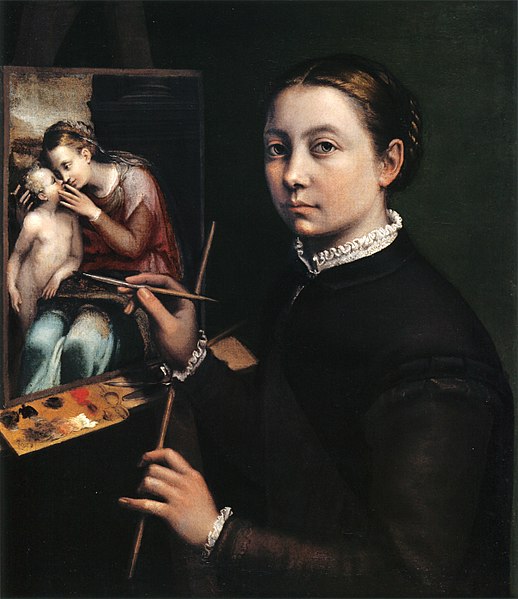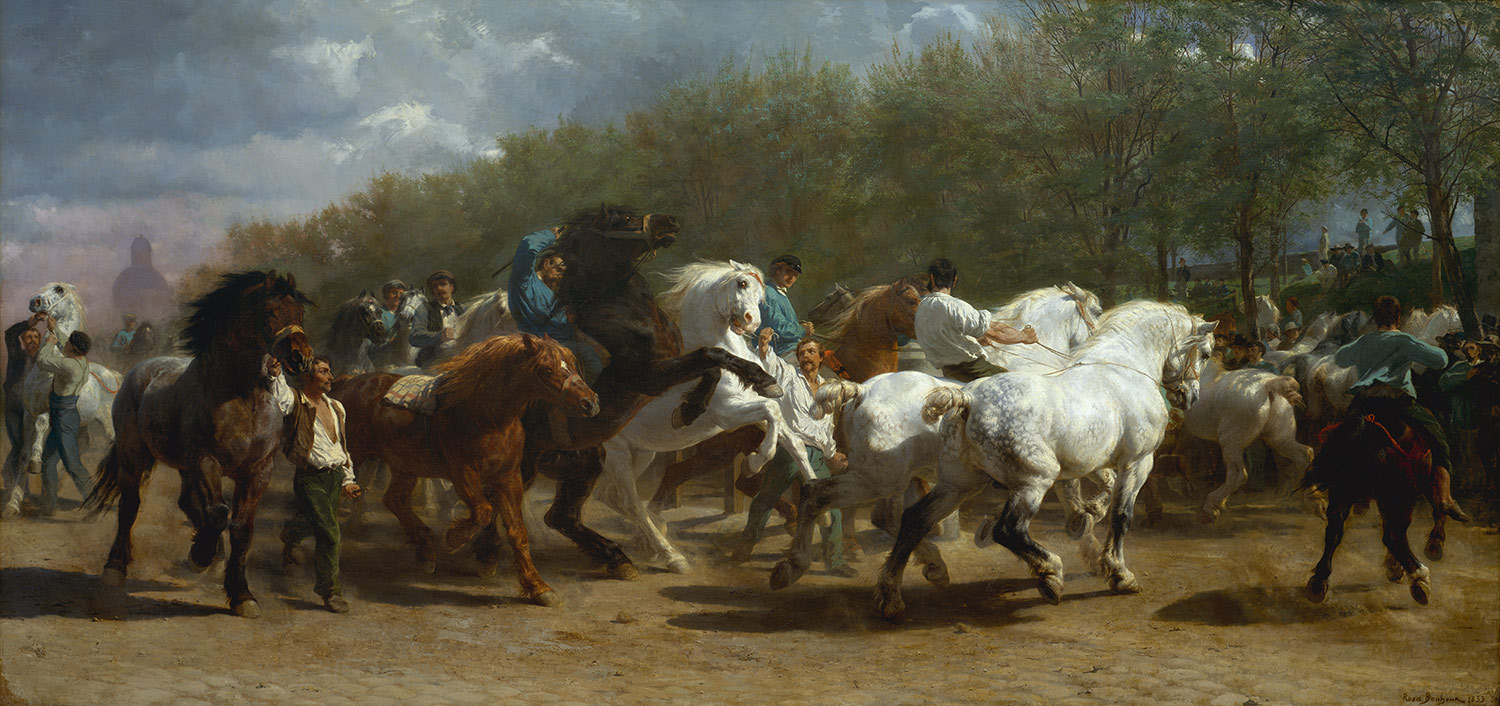Alejandro Hincapie
When examining the roles of women in European society, economic and cultural conditions largely dictated what areas of life women were designated to and what womanhood and femininity at large represented to the societies that put them there. Despite being subjugated by institutionalized and culturally constructed patriarchy, women were nonetheless still able to create art that commented on society at large and often on the way women themselves were treated.
The Middle Ages found women circumscribed to strict roles dictated by the Christian church, the prevailing institution of authority in medieval life. Women worked as either laborers performing arduous agricultural tasks under the feudal system that prevailed at the time or as merchants working in a business owned by a man—all in addition to their primary role as caregivers in the private sphere of life. However, as the Guerilla Girls state in their book The Guerilla Girls’ Bedside Companion to the History of Western Art, working women in the Middle ages were forced to concede that the “fruits of their labors belonged to men-their fathers, husbands, or brother” (Guerilla Girls 22). But despite women seeing little economic and societal gain through their own work, the importance of women in the medieval economy as a means to facilitate labor and business did ensure them a place in guilds, despite restrictions on their admittance (Chadwick 63). In guilds, women worked alongside men practicing needlework, sculpture, masonry, carpentry, painting, and decorative arts. Because medieval artists did not sign their work with their own name but with the name of the work’s patron, dispute exists today over the gender of the creators of surviving works (Guerilla Girls 21).
While guilds were one place in medieval life where women were able to produce art, monasteries provided women a place on a higher, elite class as the church was the dominant institution in medieval society. Becoming nuns for different reasons such as their family having no money for a dowry or to reform after prostitution, women in monasteries were able to exercise their intellect and artistic abilities by becoming literate, making tapestries, copying illustrated manuscripts, writing books on topics from science to the arts, and composing and preforming music (Guerilla Girls 21, 22). Though prohibited from giving sermons, entering priesthood, and teaching those outside their monastery, nuns in the Middle Ages were afforded the right to dictate their mystical visions of their encounters with God to scribes and to artists to have them illustrated (Guerilla Girls 22). These works traveled all over, spreading these women’s visions of the truths and nature of Christian faith and giving them an important voice within the church (Guerilla Girls 22). However, nuns were seen merely as the vessels of these mystical and spiritual visions and once these women began to warn against sin and corruption within the religious establishment, the church quickly silenced them. Indeed, once Hildegard von Binge’s, one of the most noteworthy nuns and head abbess, views became increasingly independent towards the end of her life, she was placed under house arrest (Guerilla Girls 25).
Arguably, moving forward into the Renaissance, women found their role and importance in society diminished. As Chadwick explains in Women, Art, and Society, societal and economic developments that were ushered in with the Renaissance, particularly “the consolidation of the state and the development of capitalism, adversely affected women by leaving them with less actual power than they had enjoyed under feudalism” (Chadwick 66). Indeed, in Renaissance Italy, women were prohibited from participating in governmental patronage and had no role in commissions carried out by guilds (Chadwick 67). In guilds, unskilled activities were relegated to women as the idea of individual, distinguished artists began to take hold in cultural and artistic production (Chadwick 69). Generally, women were afforded little to no role to play in what Chadwick explains was a “cultural renaissance oriented toward the growth and embellishment of the city as a matter of civic pride” (Chadwick 70). However, in Renaissance centers of culture and economy such as Florence, women and their role in alliances through marriage came to represent honor, wealth, and social prestige (Chadwick 76). This emphasis on women as sources of pride for individual families coincided with the growing separation between the public and private spheres of life during the Renaissance.
Despite all this, some female artists were able to gain recognition during the Renaissance, while still instilling their work with commentary about the societal conditions under which they worked. For 16th century artist Sofinisba Anguissola, several conditions aligned to help her live as an artist and reach recognition. First, she came from a family of modest nobility whose father encouraged all his children, including girls, to develop their artistic skills (Chadwick 78). Anguissola’s place as a women prevented her from seeking mentorship for herself and consequently, it was her father who reached out to Michelangelo asking for his mentorship that she eventually received and allowed her to become the Spanish court’s in-house painter (Chadwick 79). Furthermore, Anguissola as a woman was prevented from examining live nudes and human anatomy—essential to composing the ideal, Classical forms in figures valued in Renaissance oil paintings (Chadwick 78). As a result, Anguissola’s work focused on portraiture and it is her self-portraits that reveal her awareness of her condition as a women artist. In them, she is acutely aware of her role as both a women and therefore and object of art (in one self-portrait, she depicts herself being painted by a male artist) and of the unique position she found herself in as a recognized female artist (she emphasizes her role as a painter in self-portraits). Anguissola’s position as a recognized female painter put her in a unique place that as Chadwick states, “removed her from competing for commissions with her male contemporaries and that affectively placed her within a critical category of her own” (Chadwick 79).
 |
| Sofonisba Anguissolla. Self-Portrait. 1556. Oil on Canvas. * |
The 17th and 18th centuries in Europe saw much wealth brought to the continent through the colonization of the Americas, Africa, and Asia and an expansive slave trade that facilitated vast amounts of cheap labor (Guerrilla Girls 39). And while intellectual movements such as the Enlightenment took precedent across Europe and political and social revolutions swept the US and France, women still found themselves subjugated into having little roles to play outside the domestic, private sphere (Guerrilla Gils 39). Indeed, iconic philosophers like Rousseau maintained that woman’s place was at home being a caregiver as dictated by “nature” and by “reason” (Guerrilla Girls 39). Indeed, a women’s virtue was acknowledged, but only if it came from her work as a housekeeper, strictly carrying out the expected role of all women.
This confinement of women to the private sphere in the 17th and 18th centuries caused female artists to focus largely on domestic themes – genre paintings, still lives, and portraiture—as they continued to be disallowed to paint history paintings and study nude human forms. This also coincided with a growing class of wealthy merchants in Northern Europe who as patrons, wanted works that showed off their material possessions (Guerrilla Girls 39). Dutch female artists Rachel Ruysch, for example, found great success plaiting still lives of flowers – symbols of Dutch wealth and pride (Guerrilla Girls 43). While Anna Maria Sybilla Merian didn’t quite focus on indoor genre and still lives, her role as women in the home and in the garden allowed her to gain extensive visual knowledge of plant, animal, and insect life, prompting to her create an extensive visual catalogue of live specimens in the forms of drawings and engravings (Guerilla Girls 41). And the work of the 17th century female artist Judith Leyster provides perhaps the best commentary about women’s role at the time. In her painting The Proposition, she explores themes of woman’s domesticity and virtue as well as sexuality. In it, a woman is thorough engaged by her needlework as a man proposes money to her in return for sexual relationships; the women becomes a symbol for the virtue of woman in their work in the domestic sphere of life.
The 19th century brought rapid cultural, technological, and industrial changes that vastly redefined the way people interacted and communicated, as well as the way commerce was run. The arrival of the Industrial Revolution and its goals of producing the most supply with the least amount of labor afforded women the right to enter the workforce through the textile, needlework, and quilting industries. Furthermore, these changes in everyday life spurred the first true feminist reform movements. As Chadwick explains, “Nineteenth century reforms movements were part of a growing middle-class response to widespread social and economic changes following the Industrial Revolution" (Chadwick 175). These reform movements coincided with a growing sense of comradeship among women that gave them a new measured sense of freedom from the demands of their everyday home and work lives (Chadwick 217).
Female artists in the 19th century pushed the envelope in terms of subject matter and commentary in their work. Rosa Bonheur was fortunate enough to have a father who believed in the education of women and was the director of an art school, allowing her develop her skills and eventually create works worthy of recognition from the 19the century art establishment (Guerilla Girls 48). Her most recognized work, The Horse Fair (pictured below) depicts an allegorical scene in which male patriarchy is symbolized by men attempting to tame beautiful horses, symbols of female resilience. Mary Cassatt was also fortunate enough to have her family’s financial support as an artist. In Women in Black at the Opera, she demonstrates an acute understanding of women as objects of sight by adding subversion to her subject – the women becomes the spectator as she is the one with binoculars viewing something else. Cassatt, however, is strictly aware of the ever-present gaze that hovers over all women and adds a man viewing her subject from a distance. What’s more, the invention of photography provided a new medium for female artists to work in and in which paradigms did not exist for their suppression as it did in traditional oil painting. Julia Margaret Cameron, for example, took photographs of young women to personify female characters of fiction (Guerrilla Girls 52).
 |
| Rosa Bonheur. The Horse Fair. 1887. Oil on canvas. ** |
In 19th century America, women’s legal status remained limited, despite their labor being essential to building colonial America and the new independent nation it became after the Revolution. The work of female American artists Harriet Powers focused on themes central to American life in the 19th century – labor, religion, substance, and family (Guerrilla 54-55). A former slave, Powers learned the art of quilting and depicted these themes on quilts by calling attention to issues of black and women rights and the importance of their roles in American life (Guerrilla Girls 54-55).
As evident, it was largely economic and cultural conditions that dictate the role of women in Europe from the Middle Ages through the 19th century. Women artists were able to tailor both subject and meaning, usually in the European tradition of oil painting, to comment on women's role in society. Moving forward, as artistic abstraction and vast social and political change and upheaval took root in the 20th century, women would continue to make strides in both society and art.
*Image descriptions link to image source.
**The Horse Fair is currently on display at New York's Metropolitan Museum of Art. You can read about the work here.
Work Cited
Chadwick, Whitney. Women, Art, and Society. New York, NY: Thames and Hudson, 1990. Print.
The Guerrilla Girls' Bedside Companion to the History of Western Art. New York: Penguin, 1998. Print.
No comments:
Post a Comment